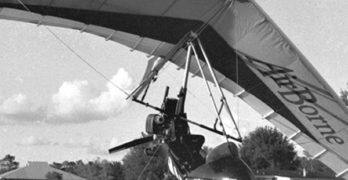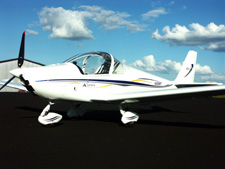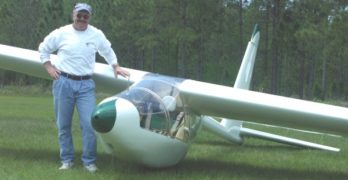AirBorne Windsports is no johnny-come-lately to the ultralight flying scene. The Australian company has been making hang gliders for the international market for years. AirBorne’s owners – Russ and Rick Duncan – once flew for Moyes Delta Pty., another Australian hang glider company (now known for its Moyes-Bailey Dragonfly aerotug), but later branched out on their own.
While both men are thirty-somethings today, they have long experience, starting with competition in hang gliders back when folks still called them “the little Duncan brothers.” They were hot pilots at a young age. Later on, they proved to be solid competitors to the Moyes juggernaut.
Then Came Trikes
A divergence occurred. After linking up with Florida designer Bobby Bailey to produce the 3-axis Dragonfly aerotug, Moyes’s interest in trikes fell by the wayside. They focused on the already popular Dragonfly for their towing promotion.
Meanwhile, the Duncans – now on their own, producing hang gliders – engaged in building trikes.
Search Results for : MG 21
Not finding exactly what you expected? Try our advanced search option.
Select a manufacturer to go straight to all our content about that manufacturer.
Select an aircraft model to go straight to all our content about that model.
Aventura II
If you’ve never flown an airplane on floats, you’ve missed a glorious experience in flying. Good as any ultralight on floats may be – and that means “quite excellent” in my opinion – even those pilots with that experience may have missed the unique sensation of a boat-hulled ultralight.
With a few thousand hours in my logbook covering everything from foot-launched hang gliders to twin-engined Barons, I can honestly say my absolute favorite hours are spent in one of two ways: first is soaring flight, but a close second is warm summer day flying in an ultralight floatplane.
It just doesn’t get any better.
Having stuck my personal opinion into this article, I must tell you about a most promising company and their 2-seat floatplane, the Aventura II. Since Arnet Pereyra exploded into the ultralight scene in 1995, this new company has filled out their line of floatplanes with a roomy and fun 2-seater which deserves a close look.
Eye On the Sky Watch
There was a time when a company called Beaver RX Enterprises – which produced the Canadian Beaver designs – was among the leading North American ultralight manufacturers.
In particular, the Beaver 550 tandem 2-seater attracted many customers. The company once claimed more than 3,500 ultralights flying. Certainly the model dominated the western Canadian market but also had a presence in the U.S. and other countries.
The old Beaver RX Enterprises company went through a number of leadership changes and, driven by overly-ambitious management goals, finally succumbed.
When I visited the now defunct company, the firm was a publicly-held corporation listed on the Vancouver Stock Exchange. Even the stock exchange has experienced a transformation, so perhaps it isn’t surprising that Beaver RX Enterprises also lost its heading.
As we’ve seen with other good designs, however – such as Quicksilvers, Phantoms or Drifters – the better ultralights can outlast their ownership. The Beaver line is among those survivors.
A Gaggle of Newly Approved SLSA Models
In the last couple weeks, the number of FAA-approved Special Light-Sport Aircraft grew to 13 models. EAA keeps a current list, proved by copies of the airworthiness certificate, but I’ll list them here as: Festival, Breezer, C42, Legend Cub, Kappa KP-5 (photo), Bravo, T-211 Thorpedo, StingSport, Echo Super, Sierra, Allegro 2000, the CT, and SportStar. (The list is presented in reverse order of approval.) In a fairly short time — the first approval was announced just over three months ago — customers have been presented with many Light-Sport Aircraft choices. I’ve flown ten of these planes. Watch for my pilot reports here on the website; a few are available now.
Legend is First Cub to Sport a Jabiru Engine
Legend Aircraft‘s Cub is one of the top selling SLSA, ranking up high with Flight Design’s CT, Fantasy Air’s Allegro, Evektor’s SportStar, and TL Ultralight’s StingSport. Both American-made Cub-like designs (Legend’s and CubCrafters‘) have been 100% Continental O-200 powered because that engine is close to what was used in the original Piper J-3 Cub, which has driven demand from customers attracted to the vintage aircraft. However, the Cubs have higher empty weights than many of their smaller metal or composite competitors — CT and StingSport, being primarily carbon fiber airframes, weigh in almost 200 pounds lighter, for example. So, when operating at higher elevations or on floats, reported Legend staffer Pat Bowers, some owners felt more power would be useful. For several weeks the Sulphur Springs, Texas factory worked to install the Jabiru 3300. The six cylinder engine is 35 pounds lighter and has 20 more horsepower, a combination said to provided spirited performance.
FK9 Wins SLSA Certification
FK Lightplanes FK9 Mk IV becomes our 21st SLSA since April 15 (a rate of 3 per month!). A longtime ultralight enthusiast with a list of FAA ratings, importer Tony Anderson has moved fast since securing distribution of Germany’s FK Lightplanes. Since my SPLOG two days ago, Tony was able to confirm by copy of his Airworthiness Certificate the SLSA approval for the FK9 Mk IV on November 17th. Here is a proven microlight design built very lightly (590 pounds empty) using fiberglass over steel construction. Powered by a Rotax 912 or 912S, FK9 cruises at 105 knots and climbs 1,500 fpm at gross (with 100 hp engine at 1,146 pounds gross weight). In service for many years in Germany, FK9 is quite popular with flight schools. It also has the slickest of wing folding mechanisms. A single person can unhook the wing — from the tip — and fold the wing.
State of the Art in Hang Gliding
In the last 10 years there have been significant developments in hang glider wings. That may come as a surprise to KITPLANES® readers. After all, the wings don’t look much different from one another, so the changes must be subtle, right?
Well, yes and no. In fact, many subtle changes have occurred as these wings have steadily progressed from a glide angle of 4:1 in the 1970s to the 15:1 glides that are common today. Even as they gained efficiency, the wings haven’t changed a lot in appearance.
But not all of the changes are so subtle. The ATOS VX I flew in late 2004 illustrates a radically different approach to wing design. The ATOS VX can achieve a glide angle of 20:1 and a sink rate of only 118 fpm. The latter number makes this wing competitive with many sailplanes, even though the pilot hangs in the airstream.
An Innovative Design
The design is produced by Aeronautic Innovation Rühle (AIR) and is the creation of Felix Rühle, who worked with composite materials for many years in his role with the German government’s Center for Research and Development in Aerospace Technology in Stuttgart.
Sebring 2004: First Impressions
The U.S. Sport Aviation Expo in October 2004 was the first event to focus exclusively on Light-Sport Aircraft.
ou never get a second chance to make a first impression. With that in mind, you might ask how visitors regarded the first U.S. Sport Aviation Expo, held in Sebring, Florida, from October 28-31, 2004. The Expo was the first of its kind aiming at the new Sport Pilot/Light-Sport Aircraft (LSA) segment, and it was a focused event, featuring only LSAs and ultralights. Is that two strikes against it or two good reasons for it to succeed?
From what I could see, those who attended the Sebring event were satisfied. Set aside for the moment reports elsewhere that the show was sparsely attended. It was the first of its kind. And as word of mouth is accepted to be the best marketing tool for shows, the attendance figures should present no surprise. The vendors were satisfied, and visitors also seemed to feel good about the selection of aircraft, the availability and ease of demo flights and the wide array of educational forums.
Part 103 Ultralights Shine
even in a Light-Sport Aircraft World.
Despite the intense focus on the FAA’s new Sport Pilot/Light-Sport Aircraft rule, EAA’s big summertime airshow brought the introduction of at least four intriguing, legitimate ultralights—aircraft that truly meet the 254-pound rule. Many observers believed LSA would sound the death knell for Part 103. I guess not!
Not only were new ultralights common, their diversity was broad. You could see a fixed-wing, a weight-shift trike, a powered parachute and a helicopter. As if seeking to prove the new rule won’t eliminate Part 103, these machines were proudly displayed by vendors who also supply larger, heavier models.
Skymaster Light Trike
One bright spot at EAA AirVenture was—literally—the glowing yellow Skymaster Light Trike. Excellent detailing kept viewers looking carefully.
Mike Lane is the man behind the project at Skymaster. He’s a hang-glider pilot looking for an easy way to launch in the flatlands of Wisconsin. His ultralight vehicle benefits from the supply bins at Skymaster powered parachutes, helping this prototype look production ready.
Ultralight Flyer Goes the Distance
There’s only one Carbon Dragon currently flying; it belongs to Steve Arndt, who calls his beautiful version of this ultralight sailplane the Magic Dragon. What he can do with it is indeed quite magical.
On a day when experienced hang glider pilots were only getting in short, half-hour soaring flights at Florida’s well-known Wallaby Ranch Flight Park, Arndt appeared to be gearing up for an entire afternoon of soaring.
“Oh, he’ll be up 3 hours, and we won’t see him until he decides to come back for dinner,” said Wallaby Ranch proprietor Malcolm Jones. Such is the nature of flying the unusually lightweight Carbon Dragon. Most soaring pilots would agree that Arndt’s sailplane and his flying are both remarkable.
An Ultralight Glider
Designed by a team led by the late Jim Maupin and Irv Culver, the Carbon Dragon has a 44-foot wingspan with full-span flaperons, an empty weight of 145 pounds and a gross weight of 335 pounds.
- « Previous Page
- 1
- …
- 84
- 85
- 86
- 87
- 88
- …
- 94
- Next Page »











